Apps
Auto Added by WPeMatico
Auto Added by WPeMatico
Policybazaar has raised $75 million as the Indian online insurance platform looks to expand its presence in UAE and Middle East.
Sarbvir Singh, chief executive of Policybazaar, told TechCrunch that the startup had raised $75 million, but didn’t elaborate. Falcon Edge Capital led the new tranche of investment in the Indian startup, which has raised about $630 million to date, according to research firm Tracxn.
The 12-year-old startup, which counts SoftBank Group’s Vision Fund and Tiger Global among its investors, is among a handful of startups that is attempting to upend India’s insurance market, which is largely commanded by state and bank-backed insurers.
Policybazaar serves as an aggregator that allows users to compare and buy policies — across categories including life, health, travel, auto and property — from dozens of insurers on its website without having to go through conventional agents.
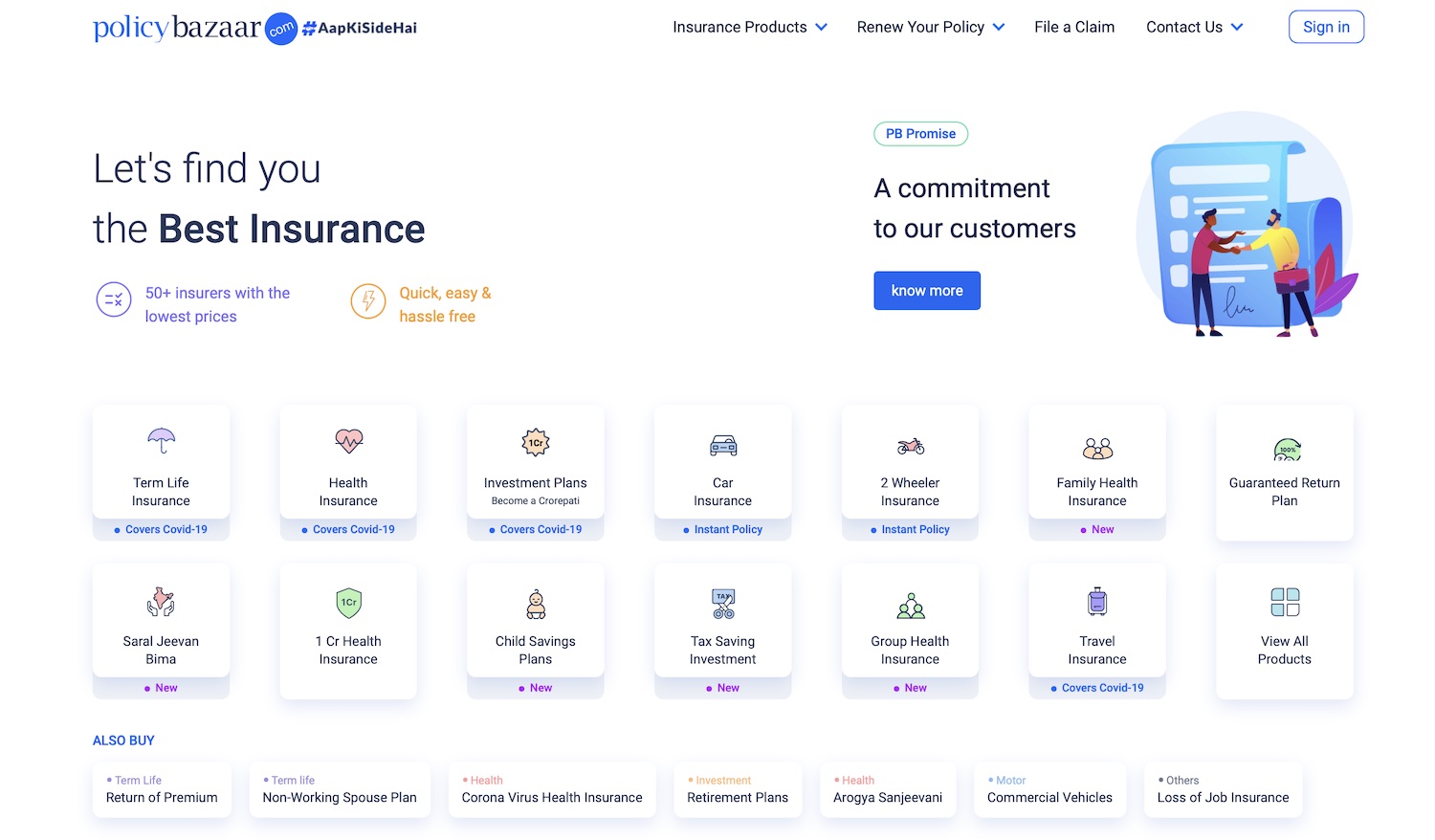
A screengrab of Policybazaar website
In India only a fraction of the nation’s 1.3 billion people currently have access to insurance and some analysts say that digital firms could prove crucial in bringing these services to the masses. According to rating agency ICRA, insurance products had reached less than 3% of the population as of 2017.
An average Indian makes about $2,100 in a year, according to World Bank. ICRA estimated that of those Indians who had purchased an insurance product, they were spending less than $50 on it in 2017.
In a recent report, analysts at Bernstein estimated that Policybazaar commands 90% of share in the online insurance distribution market. The platform also sells loans, credit cards and mutual funds. The startup says it sells over a million policies a month.
“India has an under-penetrated insurance market. Within the under-penetrated landscape, digital distribution through web-aggregators like Policybazaar forms <1% of the industry. This offers a large headroom for growth,” Bernstein analysts wrote to clients.
The startup, which is working on an initial public offering slated for next year, said it will use the fresh investment to expand its presence across the UAE and Middle East regions.
“PolicyBazaar has shown stellar innovation, execution, and relentlessness in establishing itself as the market leader in online insurance aggregation in India. We believe the playbook it has established over the last 10 years in being the most efficient sales channel for insurance manufacturers, can act as a catalyst to gain market leadership in the GCC,” said Navroz Udwadia, co-founder of Falcon Edge Capital, in a statement.
Early Stage is the premier “how-to” event for startup entrepreneurs and investors. You’ll hear firsthand how some of the most successful founders and VCs build their businesses, raise money and manage their portfolios. We’ll cover every aspect of company building: Fundraising, recruiting, sales, product-market fit, PR, marketing and brand building. Each session also has audience participation built-in — there’s ample time included for audience questions and discussion. Use code “TCARTICLE at checkout to get 20% off tickets right here.
Powered by WPeMatico
Google is making changes to its parental control system, Family Link, that aims to better reflect parents’ changing views on children’s screen time. In the pre-pandemic world, parents were more likely to see screen time as something in need of restriction — they’d rather their kids get offline or go outside to play with friends, perhaps. But the challenges of a locked-down world and the push toward virtual learning have impacted parents’ views. Google says today’s parents are more concerned about how kids are spending time on their devices, not how much time is being spent.
It’s a concession to a world where devices have become a savior of sorts to families who’ve stayed at home to avoid COVID — where they’ve been restricted from seeing extended family and friends, and where schools are closed and playdates and parties were cancelled. Parents came to realize that screen time in and of itself isn’t necessarily something to be avoided; they just wanted more control over how it’s used.
With the Family Link update, parents can now choose to make remote learning apps “always allowed,” so they don’t count toward overall screen time daily limits. This could include not only those apps that are used to attend school or communicate with teachers, but others that have popped up to help kids learn and be entertained, like the supplemental resources the school suggests — or the apps parents allow during break times from virtual class.
Parents will also now have access to more detailed daily, weekly and monthly activity reports that provide both an overview of how the child is spending their time in apps, as well as how screen time usage has changed over a week or month, and what portion of time was spent in the “always allowed” apps. This gives parents a better idea of what screen time was used for education versus play.
On Android, Family Link users will also be able to browse through a selection of teacher-recommended apps from the Google Play catalog for kids under 13 in the U.S. And parents can also now set screen time limits directly from the child’s device on Android.
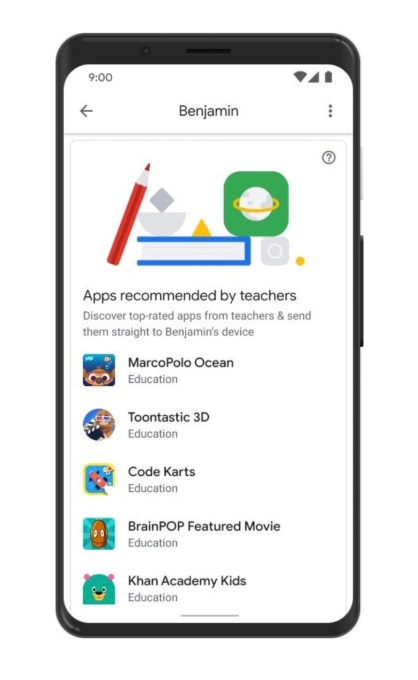
Image Credits: Google
Though these updates will remain useful in a post-pandemic world where parents hold a more nuanced view of screen time, it’s unfortunate that Google waited until so late in the pandemic to roll out these changes. As more people in the U.S. are being vaccinated, restrictions are lifting — including the re-opening of schools in many places. That means parents’ stress over kids’ increased screen time usage will soon become a moot point. The devices will be replaced with in-person learning, and screen time may become villainized yet again.
Related to today’s news, Google has launched a new website for families whose kids are beginning to use technology (families.google). The company also launched a new content series with meditation app Headspace that will help families with kids practice mindfulness together. Again, that’s a resource that was desperately needed in 2020 during the pandemic’s heights, more so than it is today as the world begins reopening.
Still, the pandemic has forced families to think more about screen time and what sort of on-device experiences they want their children to have. As a result of this increased scrutiny, social apps like TikTok and Instagram — the latter just today, in fact — have rolled out more family-friendly safety features, aimed at encouraging parents to see their apps in a better light, rather than being the first to go when screen time gets locked down. It has also encouraged new hybrid learning and education startups to launch, hoping to build out a new category of edutainment apps that can avoid screen-time lockdowns.
It’s worth noting, too, that the update to Family Link follows the addition of an App Store privacy label on iOS, which confirms the data Google collects on users. The app, until recently, had been one of the many Google iOS apps that had seen updates stalled due to the lack of labeling.
Early Stage is the premier “how-to” event for startup entrepreneurs and investors. You’ll hear firsthand how some of the most successful founders and VCs build their businesses, raise money and manage their portfolios. We’ll cover every aspect of company building: Fundraising, recruiting, sales, product-market fit, PR, marketing and brand building. Each session also has audience participation built-in — there’s ample time included for audience questions and discussion. Use code “TCARTICLE at checkout to get 20% off tickets right here.
Powered by WPeMatico
You might think that Clubhouse is the final word on audio-centric social networks, but a San Francisco startup called Swell is launching its own iOS and Android app focused on voice conversations.
The big difference: While conversations on Clubhouse all happen in real time — meaning that you’ve got to listen live or miss it all (at least for now) — Swell is focused on asynchronous comments. In other words, users post a standalone audio clip that can be up to five minutes in length (with an accompanying image and links), then other users can browse, listen and leave their own audio responses in their own time.
Swell supports audio-only group chats and private conversations, as well as public “Swellcasts” — think of a bite-sized podcast, or a Clubhouse-style conversation that’s structured more like a comment thread than a free-for-all. Users can also promote their public posts through their own pages on the Swellcast website.
Swell is led by husband-and-wife team Sudha Varadarajan and Arish Ali, who previously founded e-commerce company Skava and sold it to Infosys.
Varadarajan (the startup’s CEO) described the app as an attempt to “democratize” audio content creation, with no special equipment or serious production required, and allowing users to talk about anything. (In one example, the Swellcaster was outside talking about their front lawn.)
At the same time, she suggested that the app was created less as a response to Clubhouse and more as a general antidote to social media, where the pair saw increasing polarization and fewer genuine conversations.
Audio is hardly immune to ranting and anger — just look at talk radio. But Varadarajan suggested that making the posts asynchronous doesn’t just make it easier for listeners to catch up; it also improves the quality of the conversation: “People really think about what they’re going to say.”
She added that the company is determined to avoid any ad-based business models and instead make money by charging for premium tools and Swellcasts.
Until now, Swell has only been open to a small group of users. Today it’s launching more broadly, in advance of its session tomorrow at the virtual SXSW, “Voice is transforming our online presence. Why?”
Powered by WPeMatico
A newly launched Mac app called Superpowered aims to make it easier to stay on top of all your Zoom calls and Google Meets, without having to scramble to find the meeting link in your inbox or calendar app at the last minute. Instead of relying on calendar reminders, Superpowered offers a notification inbox for the Mac menu bar that alerts you to online meetings just before they start, which you can then join with a click of a button.
To use Superpowered, you first download the app then authorize it to access to your Google Calendar. The app currently works with any Google account, including G Suite, as well as your subscribed calendars.
Once connected, Superpowered pulls all your events into the menu bar, which you can view at any time throughout the day with a click or by using the keyboard shortcut Command+Y.
When you have a meeting coming up, Superpowered will display a drop-down notification to alert you, or you can opt for a more subtle halo effect instead to have it get your attention. You can also configure other preferences — like whether you want a chime to sound, how far in advance you want to be alerted, whether you want a meeting reminder as text to appear in the menu bar ahead of the meeting and so on.
When it’s time for the meeting, all you have to do is click the button it displays to join your Zoom call or Google Meet. The solution is simple, but effective. The startup plans to add support for more integrations going forward, including Microsoft Teams, Cisco WebEx and others.
The idea for the app comes from four computer science and software engineering students from the University of Waterloo, who previously interned at tech companies like Google, Facebook, Asana and Spotify.
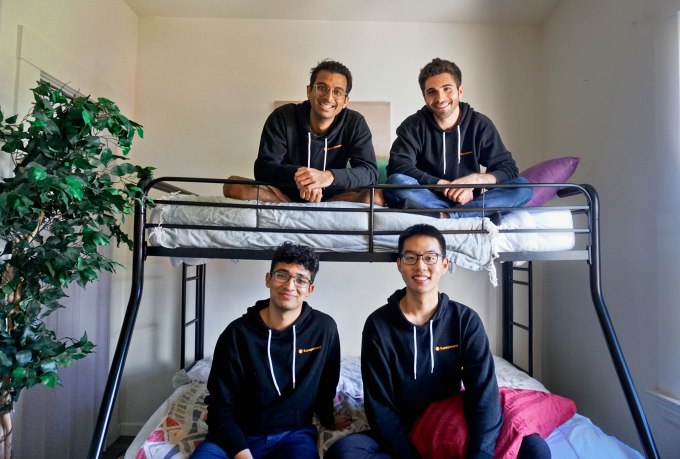
Team photo. Image Credits: Superpowered
Wanting to build a startup of their own, the team applied to the accelerator Y Combinator with an idea to build a lecture platform for professors. But they soon faced issues in keeping up with their own calendar appointments as they began to conduct user research interviews.
“We were struggling to keep up with each other’s calendars and balance all these meetings throughout the day,” explains Superpowered co-founder Jordan Dearsley, who built the service alongside teammates Nikhil Gupta, Ibrahim Irfan and Nick Yang. “We would be at lunch and be like, ‘Oh shoot, we have a meeting now — I have to run!’ or just completely miss it altogether,” he says.
Irfan had the idea to just put a button in the Mac menu bar to make it easier to join Zoom meetings and soon the team pivoted to work on Superpowered instead.
The product itself is very new. Development work began roughly two months ago and Superpowered opened up to users just last month — a quick pace that Dearsley says was possible because three of the four team members are engineers, and the other, Yang, is the designer.

Image Credits: Superpowered
Although it’s a paid product offered at $10 per month, Superpowered already has hundreds of users who are interacting with the app, on average, 10 times per day. Busier users, like product managers, are clicking on Superpowered as many as 20 to 40 times per day — an indication that it’s found a place in users’ workflows. In the month since its launch, the app has connected users with over 10,000 online meetings, the company says.
Superpowered is not the first to add calendar appointments to the Mac’s menu bar. It competes with a range of products, like MeetingBar, Meeter, Next Meeting and others. But users have been responding to Superpowered’s sleek, clean design.
The company also has a vision for the product’s future that extends beyond meetings. After solving this particular pain point, Superpowered plans to broaden its scope to fix other annoyances for knowledge workers — like Slack notifications, for example.
“It’s really annoying to be pinged all the time while I’m coding … and I don’t know if it’s something that’s worth seeing because Slack doesn’t really give me those controls or ability to peek,” explains Dearsley. Meanwhile, Mac’s built-in Notification Center isn’t smart enough to show you just those items that you really need to know about.
To address this, the team is now working on a Slack integration that will let you quickly check your messages and reply without having to launch the Slack app. Further down the road, the team wants to integrate support for other platforms — like Google Docs, JIRA and GitHub — which would all be pulled into Superpowered’s universal notification inbox.
For the time being, Superpowered is $10 per month for Mac users or $8 per month for those who sign up with a team. Annual pricing is not yet available.
Powered by WPeMatico
A team of mobile app engineers and designers from companies like Rent the Runway, ClassPass, Kickstarter and others, are now launching their own startup, Runway, to address the common pain points they experienced around the mobile app release cycle. With Runway, teams can connect their existing tools to keep track of the progress of an app’s release, automate many of the manual steps along the way and better facilitate communication among all those involved.
“Mobile app releases are exercises in herding cats, we often say. There’s a lot of moving pieces and a lot of fragmentation across tools,” explains Runway co-founder Gabriel Savit, who met his fellow co-founders — Isabel Barrera, David Filion, and Matt Varghese — when they all worked together as the first mobile app team at Rent the Runway.
“The result is a lot of overhead in terms of time spent and wasted, a lot of back and forth on Slack to make sure things are ready to ship,” he says.
Typically, interdisciplinary teams involving engineers, product, marketing, design, QA and more, will keep each other updated on the app’s progress using things like spreadsheets and other shared documents, in addition to Slack.
Meanwhile, the actual work taking place to prepare for the release is being managed with a variety of separate tools, like GitHub, JIRA, Trello, Bitrise, CircleCI and others.
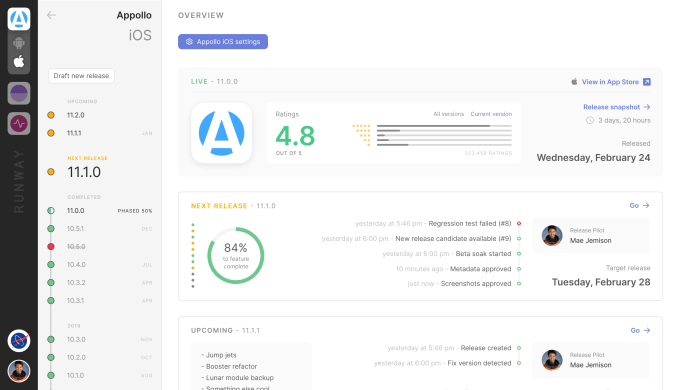
Image Credits: Runway
Runway is designed to work as an integration layer across all the team’s tools. Using a simple OAuth authentication flow, the team connects whichever tools they use with Runway, then configure a few settings that allow Runway to understand their unique workflow — like what their branching strategy is, how they create release branches, how they tag releases and so on.
In other words, teams train Runway to understand how they operate — they don’t have to change their own processes or behavior to accommodate Runway.
Once set up, Runway reads the information from the various integration points, interprets it and takes action. Everyone on the team is able to log into Runway via its web interface and see exactly where they are in the release cycle and what still needs to be done.
“We’re forming this glue, this connective tissue between all of the moving pieces and the tools, and creating a true source of truth that everybody can refer to and sync or gather around. That really facilitates and improves the level of collaboration and getting people on the same page,” Savit says.
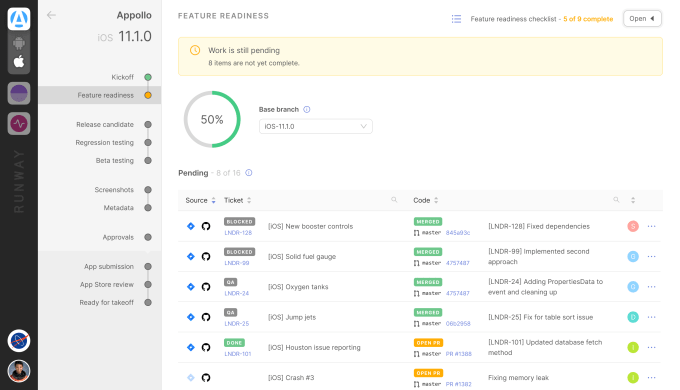
Image Credits: Runway
As the work continues, Runway helps to identify problems, like missing JIRA tags, for example. It then automatically backfills those tags. It can also help prevent other mistakes, like when the incorrect build is being selected for submission.
Another automation involves Slack communication. Because Runway understands who’s responsible for what, it can direct Slack notifications and updates to specific members of the team. This reduces the noise in the Slack channel and ensures that everyone knows what they’re meant to be working on.
Currently, Runway is focused on all the parts of the mobile app release cycle from kickoff to submission to the actual app store releases. On its near-term roadmap, it plans to expand its integrations to include connections to things like bug reporting and beta testing platforms. Longer term, the company wants to expand its workflow to include launching apps on other platforms, like desktop.
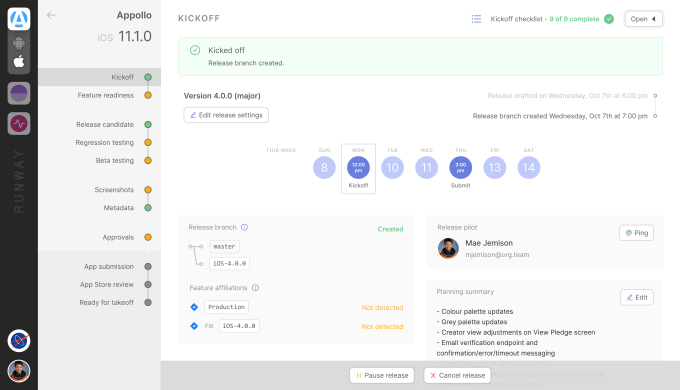
Image Credits: Runway
The startup is currently in pilot testing with a few early customers, including ClassPass, Kickstarter, Capsule and a few others. These customers, though not all yet paying clients, have already used the system in production for over 40 app release cycles.
The startup’s pricing will begin at $400 per app per month, which allows for unlimited release managers and unlimited apps, access to all integrations, and iOS and Android support, among other things. Custom pricing will be offered to those who want higher levels of customer support and consulting services.
The startup doesn’t have an exact ETA to when it will launch publicly as it’s working to onboard each customer and work closely with them to address their specific integration needs for now. Today, Runway supports integrations with the App Store, Google Play, GitHub, JIRA, Slack, Circle, fastlane, GitLab, Bitrise, Linear, Jenkins and others, but may add more integrations as customers require.
Runway’s team of four is mostly New York-based and is currently participating in Y Combinator’s Winter 2021 virtual program. The company hasn’t yet raised a seed round.
Powered by WPeMatico
Meet Detail, a new startup working on an app for iOS and macOS so that you can turn your iPhone into a software-optimized camera for live video. The startup wants to make it easy to use the phone that you have in your pocket with the livestreaming platform that you already use, such as Zoom, Google Meet, Twitch, Hopin or YouTube Live.
Over the past year, if you have had to present something to a large audience over a livestream, chances are you’ve faced a few challenges. First, as Joanna Stern of the Wall Street Journal demonstrated, laptop webcams suck. There’s no way you’re going to look good with your computer.
Second, if you’re willing to invest some money, you can buy a ring light, a dedicated camera, a good microphone, etc. The issue is that it’s expensive. More importantly, it’s been really hard to buy some of this stuff as many remote workers have been looking for those devices.
Third, you might be good at teaching something, but not good at video production. Those are different skills and somehow people are telling you that you should know everything about white balance, anti-flickering and more.
As for Detail, the company wants to make it as easy as possible to go from zero to livestream. The best camera that you have is most likely the one in your pocket, right there on the back of your smartphone. For the past few years, computational photography has led to tremendous improvements when it comes to taking photos with your phone. But there’s still some work to do on the livestreaming front.
Detail founder Paul Veugen rightly points out that hosting a live video has become a commodity. But everything that happens before you send the video feed over the internet could be improved.
At first Detail is going to be an iPhone and Mac app that works hand in hand like Camo and EpocCam. There are going to be some easy-to-use settings to tweak color grades, add filters, etc. It’s going to be a more opinionated take on the smartphone-as-a-webcam movement.
Behind the scenes, the team is composed of some of the people that worked on Human, an app I started covering way back in 2013. Human was a passive fitness tracking app — you could set it up and get insights about how active you had been over the past few days. Essentially, it was like Apple’s activity rings before Apple introduced the Apple Watch. Human was acquired by Mapbox in 2016.
Detail raised a $2 million pre-seed round led by Connect Ventures. Hustle Fund, Alexander Ljung, Anke Huiskes, Arthur Kosten, Elodie and Tony Jamous, Hiten Shah, Janis Krums, Mart Kelder, Micha Hernandez van Leuffen, Othman Laraki, Omri Amir and Sten Tamkivi are also participating in the round.
As you can see, Detail is still in active development and the beta test is going to start soon. But it’s an intriguing app and I’m going to keep an eye on it to see how it pans out.
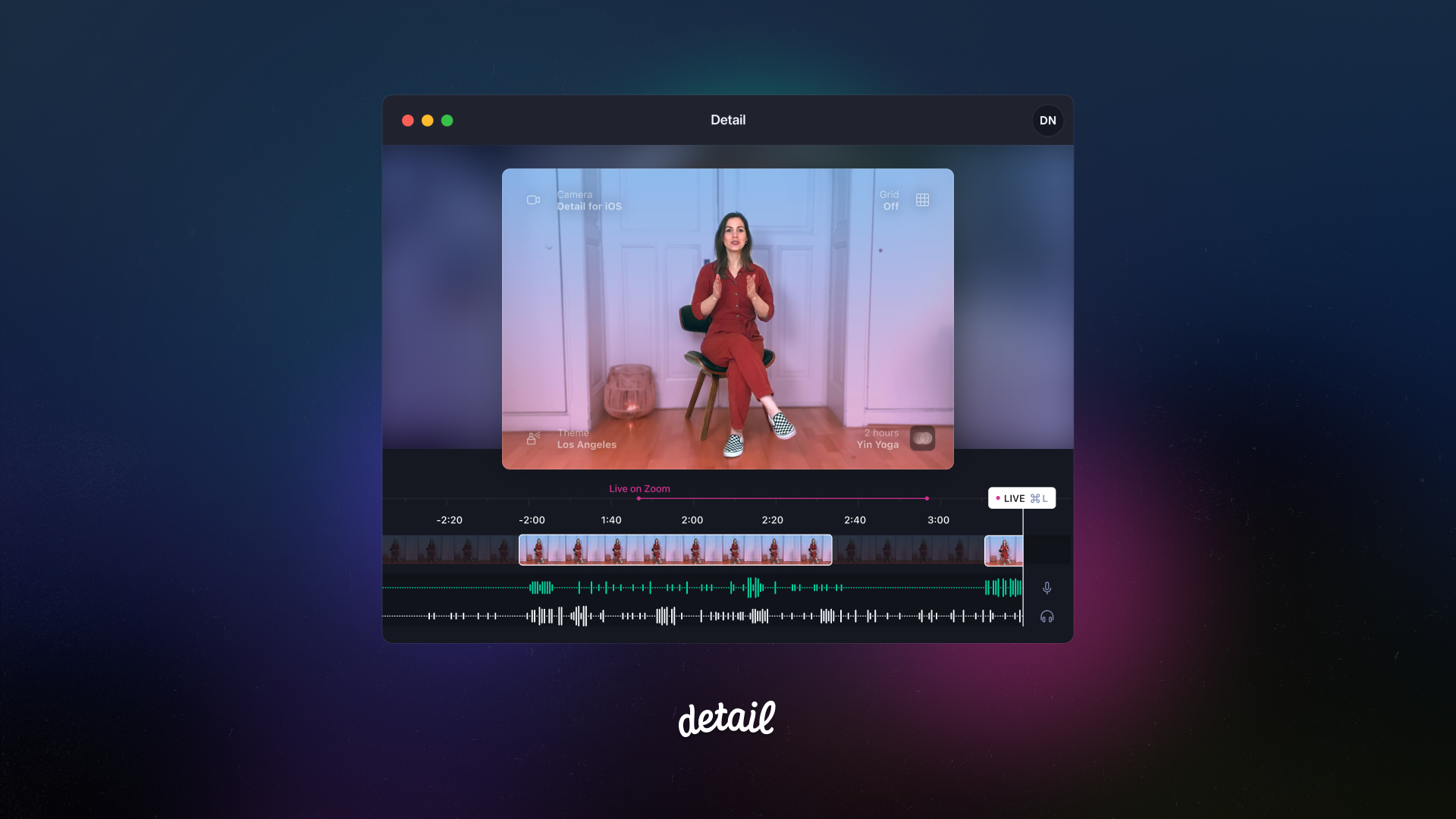
Image Credits: Detail
Powered by WPeMatico
Before kids graduate to the expansive virtual worlds in games like Roblox, Minecraft and Fortnite, they often get their start in online social gaming with a game like Animal Jam. Here, kids learn to personalize their avatar, explore a world, chat with other players and trade items in a safe environment with parental controls. Today, the company behind this popular title, WildWorks, is launching a new game, Fer.al, which builds on Animal Jam’s legacy while catering to a slightly older crowd of Gen Z teens.
“When we started talking about Fer.al, it was the idea of where do kids go when they age out of Animal Jam?,” explains Clark Stacey, co-founder and CEO of WildWorks. “Because there isn’t a transitional space between a completely walled garden like Animal Jam and … Instagram and the adult social networks and games that don’t have those same protections,” he continues.
“We knew we wanted to provide a place for these older kids to go where the walls are a little bit lower,” Stacey adds.
The new game is meant to cater to older kids — meaning young teens ages 13 to around 18 — who are now choosing their own games, have their own email address and don’t need parental permission to play. The guardrails on chat also won’t be as high on Fer.al as on Animal Jam and will focus more on preventing bullying and abuse than blocking words. Players will also be able to connect their online social accounts to their game accounts in the future.

Image Credits: WildWorks
With Fer.al, WildWorks is introducing another animal-centered title, but this time it’s moving into the fantasy realm. Players choose between bipedal humanoid creatures based on folklore and myth including a Kitsune, Senri, Dragon, Jackelope, Werewolf, Kirin or a Shinigami, with more to come in time.
The characters’ style was inspired by Animal Jam fan art, Stacey says, where kids would create animal avatars that were sort of a mix between manga, Animal Jam’s style, and other, older animation styles.
Like its predecessor, Fer.al players will also be able to personalize their character and change their appearance, design their personal space (this time, a “sanctuary” instead of a “den,”) discover a world where they can interact with other players, collect items and trade, and venture on quests. But the storyline has also evolved to reflect teens’ interests, including their growing understanding of social media and the desire to grow an online fan base.
The larger narrative involves a reality show where two warring queens, Aradia and Delilah — each with their own Instagram account, naturally — are angling for control. The company isn’t offering a lot of details as to how this narrative plays out in the long term, but it will involve weekly and monthly contests as the game ramps up, in addition to the everyday missions and quests that are undertaken to gain ingredients to create new clothes or a new “glamour” (a rendering effect that goes around your character.)

Image Credits: WildWorks
Much like Animal Jam — or even other virtual worlds like some Roblox games — players are meant to engage in cooperative gameplay to advance. There will be tasks you can’t complete on your own, meaning you’ll need to interact and chat. You will also be able to join factions, initially driven by the two queens, as the game advances.
Another notable aspect to Fer.al is that it’s largely designed to cater to girl gamers.
“It’s certainly not intended to be to the exclusion of boys who are in this age range,” explains Stacey. “But we recognize the fact that, among the most engaged Animal Jam players, it’s about 80% girls. We’ve leaned into that pretty heavily in Animal Jam — we’re trying to feature a lot of female scientists and working with them on causes that promote girls in STEM. So we know a lot of the built-in audience is coming from that,” he says.
“And I think the need that we recognized is that it’s not hard for adolescent boys to find online communities that jive with them. It’s pretty hard for girls to find the same thing. So, as we’re creating this community — everything from the rules to the visuals — we are very conscious of that. And the people that we’re going to and asking for what works for you and what doesn’t, is primarily girls,” he adds.

Image Credits: WildWorks
Building off the Animal Jam fan base has been an advantage for getting Fer.al off the ground. Today, Animal Jam has anywhere between 2.5 million to 4 million monthly active users out of a total of 135 million registered accounts. The gulf between the registered and active figures is indicative of how many kids have grown out of Animal Jam since its October 2010 launch. But Stacey admits the title has seen some decline since its peak usage, as well.
Still, there’s a lot of interest in what WildWorks does next, it seems.
Within a week of launching the Fer.al website, the game had 75,000 kids sign up to become beta testers. The testers were brought into the beta slowly, starting in April 2020, and initially on desktop only. Now, the beta version of the game sees daily actives in the low 10,000’s pre-launch. On the Apple App Store and Google Play, over 100,000 people have registered for the pre-release, as well.
Like Animal Jam, Fer.al will offer a freemium experience. But while Animal Jam generated nearly 80% of revenues through subscriptions, Fer.al will use a season pass model of monetization. Users buy the season — priced around $10 to $20 — via an in-app purchase, which will unlock unique items and experiences specific to that season. It expects to launch around seven seasons per year.

Image Credits: WildWorks
The company didn’t offer seasons until later in the beta test, but Stacey says the conversion rate was at “the high end of our expectations so far on desktop.” If the mobile conversion rates remain as high as desktop, it will be in the range to start investing in user acquisition, he says. The company may also consider ads at a later date as well as merchandise, if all goes well.
Salt Lake City-headquartered WildWorks (formerly Smart Bomb Interactive) is majority owned by Signal Peak Ventures, which has invested $20+ million into the company over the years. The company shifted in 2008 to focus on its own IP, resulting in the launch of Animal Jam and other titles.
Over the past few years, WildWorks’ revenue — largely from Animal Jam and another game, Tag with Ryan — has ranged between $20+ million to below $30 million. If Fer.al is able to successfully capture the Animal Jam graduates who are looking to move up to “older kid” gameplay, it could grow that revenue base by a sizable amount.
Fer.al is launching publicly today in all countries and will be available initially in English. It can be played on PC, Mac, iOS and Android.
Early Stage is the premier ‘how-to’ event for startup entrepreneurs and investors. You’ll hear firsthand how some of the most successful founders and VCs build their businesses, raise money and manage their portfolios. We’ll cover every aspect of company building: Fundraising, recruiting, sales, product-market fit, PR, marketing and brand building. Each session also has audience participation built in — there’s ample time included for audience questions and discussion.
Powered by WPeMatico
A lot of our communication these days with each other is digital, and today one of the companies enabling that — with APIs to build chat experiences into apps — is announcing a round of funding on the back of some very strong growth.
Stream, which lets developers build chat and activity streams into apps and other services by way of a few lines of code, has raised $38 million, funding that it will be using to continue building out its existing business as well as to work on new features.
Stream started out with APIs for activity feeds, and then it expanded to chat, which today can be integrated into apps built on a variety of platforms. Currently, its customers integrate third-party chatbots and use Dolby for video and audio within Stream, but over time, these are all areas where Stream itself would like to do more.
“End-to-end encryption, chatbots: We want to take as many components as we can,” said Thierry Schellenbach, the CEO who co-founded the startup with the startup’s CTO Tommaso Barbugli in Amsterdam in 2015 (the startup still has a substantial team in Amsterdam headed by Barbugli, but its headquarters is now in Boulder, Colorado, where Schellenbach eventually moved).

Image Credits: Stream (opens in a new window)
The company already has amassed a list of notable customers, including Ikea-owned TaskRabbit, NBC Sports, Unilever, Delivery Hero, Gojek, eToro and Stanford University, as well as a number of others that it’s not disclosing across healthcare, education, finance, virtual events, dating, gaming and social. Together, the apps Stream powers cover more than 1 billion users.
This Series B round is being led by Felicis Ventures’ Aydin Senkut, with previous backers GGV Capital and 01 Advisors (the fund co-founded by Twitter’s former CEO and COO, Dick Costolo and Adam Bain) also participating.
Alongside them, a mix of previous and new individual and smaller investors also participated: Olivier Pomel, CEO of Datadog; Tom Preston-Werner, co-founder of GitHub; Amsterdam-based Knight Capital; Johnny Boufarhat, founder and CEO of Hopin; and Selcuk Atli, co-founder and CEO of social gaming app Bunch (itself having raised a notable round of $20 million led by General Catalyst not long ago).
That list is a notable indicator of what kinds of startups are also quietly working with Stream.
The company is not disclosing its valuation but said chat revenue grew by 500% in 2020.
Indeed, the Series B speaks of a moment of opportunity: It is coming only about six months after the startup raised a Series A of $15 million, and in fact Stream wasn’t looking to raise right now.
“We were not planning to raise funding until later this year but then Aydin reached out to us and made it hard to say no,” Schellenbach said.
“More than anything else, they are building on the platforms in the tech that matters,” Senkut added in an interview, noting that its users were attesting to a strong return on investment. “It’s rare to see a product so critical to customers and scaling well. It’s just uncapped capability… and we want to be a part of the story.”
That moment of opportunity is not one that Stream is pursuing on its own.
Some of the more significant of the many players in the world of API-based communications services like messaging, activity streams — those consolidated updates you get in apps that tell you when people have responded to a post of yours or new content has landed that is relevant to you, or that you have a message, and so on — and chat include SendBird, Agora, PubNub, Twilio and Sinch, all of which have variously raised substantial funding, found a lot of traction with customers, or are positioning themselves as consolidators.
That may speak of competition, but it also points to the vast market there for the tapping.
Indeed, one of the reasons companies like Stream are doing so well right now is because of what they have built and the market demand for it.
Communications services like Stream’s might be best compared to what companies like Adyen (another major tech force out of Amsterdam), Stripe, Rapyd, Mambu and others are doing in the world of fintech.
As with something like payments, the mechanics of building, for example, chat functionality can be complex, usually requiring the knitting together of an array of services and platforms that do not naturally speak to each other.
At the same time, something like an activity feed or a messaging feature is central to how a lot of apps work, even if they are not the core feature of the product itself. One good example of how that works are food ordering and delivery apps: they are not by their nature “chat apps” but they need to have a chat option in them for when you do need to communicate with a driver or a restaurant.
Putting those forces together, it’s pretty logical that we’d see the emergence of a range of tech companies that both have done the hard work of building the mechanics of, say, a chat service, and making that accessible by way of an API to those who want to use it, with APIs being one of the more central and standard building blocks in apps today; and a surge of developers keen to get their hands on those APIs to build that functionality into their apps.
What Stream is working on is not to be confused with the customer-service focused services that companies like Zendesk or Intercom are building when they talk about chat for apps. Those can be specialized features in themselves that link in with CRM systems and customer services teams and other products for marketing analytics and so on. Instead, Stream’s focus are services for consumers to talk to other consumers.
What is a trend worth watching is whether easy-to-integrate services like Stream’s might signal the proliferation of more social apps over time.
There is already at least one key customer — which I am now allowed to name — that is a steadily growing, still young social app, which has built the core of its service on Stream’s API.
With just a handful of companies — led by Facebook, but also including ByteDance/TikTok, Tencent, Twitter, Snap, Google (via YouTube) and some others depending on the region — holding an outsized grip on social interactions, easier, platform-agnostic access to core communications tools like chat could potentially help more of these, with different takes on “social” business models, find their way into the world.
“Stream’s technology addresses a common problem in product development by offering an easy-to-integrate and scalable messaging solution,” said Dick Costolo of 01 Advisors, and the former Twitter CEO, in a statement. “Beyond that, their team and clear vision set them apart, and we ardently back their mission.”
Updated to correct that the revenue growth is not related to the valuation figure.
Powered by WPeMatico
Earlier this year, TikTok was spotted testing a new Q&A feature that would allow creators to more directly respond to their audience’s questions using either text or video. Today, the company has announced the feature is now available to all users globally. With the release of TikTok Q&A, as the feature is officially called, creators will be able to designate their comments as Q&A questions, respond to questions with either text comments or video replies and add a Q&A profile link to their bios, among other things. The feature also works with live videos.
TikTok Q&A grew out of a way that creators were already using the video platform to interact with viewers. Often, after posting a video, viewers would have follow-up questions about the content. Creators would then either respond to those questions in the comments section or, if the response was more involved, they might post a second video instead.
The Q&A feature essentially formalizes this process by making it easier for creators — particularly those with a lot of fans — to identify and answer the most interesting questions.
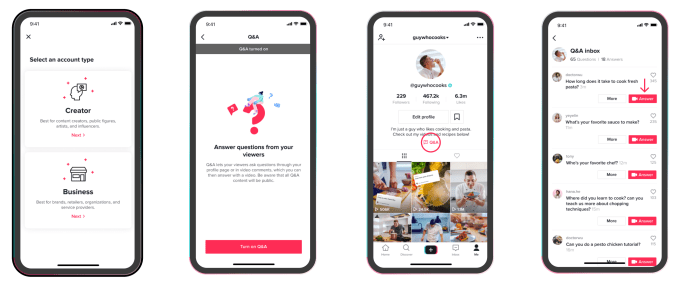
Image Credits: TikTok
To use Q&A, viewers will first designate their comment as a Q&A question using a new commenting option. To do so, they’ll tap the Q&A icon to the right side of the text entry field in comments. This will also label their comment with the icon and text that says “Asked by” followed by the username of the person asking the question. This makes it easier for creators to see when scanning through a long list of comments on their video.
The feature will also feed the question into the creator’s new Q&A page where all questions and answers are aggregated. Users can browse this page to see all the earlier questions and answers that have already been posted or add a new question of their own.
Creators will respond to a Q&A question with either text or video replies, just as they did before — so there isn’t much new to learn here, in terms of process.
They can also add Q&A comments as stickers in their responses where the new video will link back to the original, where the question was first asked, similar to how they’re using comment stickers today.
The feature will also be available in TikTok LIVE, making it easier for creators to see the incoming questions in the stream’s chat from a separate panel.
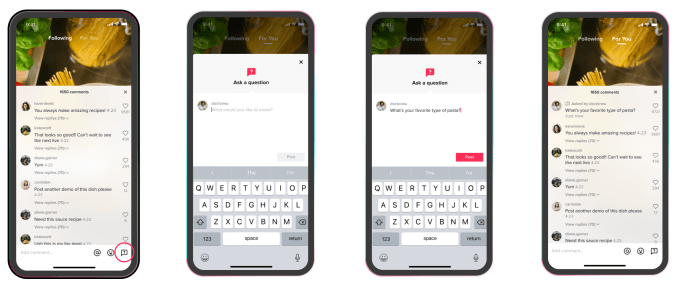
Image Credits: TikTok
As a part of this launch, a Q&A profile link can be added to creators’ Profile bios, which directs users to the Q&A page where everything is organized.
During tests, the feature was only made available to creators with public accounts that had more than 10,000 followers and who opted in. Today, TikTok says it’s available to all users with Creator Accounts.
To enable the feature on your own profile, you’ll go to the privacy page under Settings, then select “Creator,” tap “Q&A” and then “Turn on Q&A.” (If users don’t already have a Creator account, they can enable it for themselves under settings.)
The feature is rolling out to users worldwide in the latest version of the TikTok app now, the company says.
@tiktokYou can now ask and answer any questions on LIVE with the new Q&A feature. Check it out now!♬ original sound – TikTok
Powered by WPeMatico
This morning Square, a fintech company that serves both individuals and companies, announced that it has purchased a majority stake in Tidal, a music streaming service. The deal, worth some $297 million, will allow artist-partners to keep their ownership in the music company.
Square CEO Jack Dorsey used his other company, Twitter, this morning to explain the deal. Dorsey seemed to expect the transaction to generate skepticism — which it definitely has. In his opening message, he asked a rhetorical question: “Why would a music streaming company and a financial services company join forces?!”
Why indeed. Dorsey’s expectation is that his company can replicate the success of Cash App and other Square products in the world of music. Noting that “new ideas are found at the intersection,” Dorsey argued that the confluence of “music and the economy” is one such point of convergence.
The deal also installs musician and businessperson Jay-Z on Square’s board.
Some early reaction to the deal has proved negative. It’s not hard to riff on the seeming strangeness of Square and Tidal as a pair. And Square has made acquisitions in the past that appeared adjacent and failed to stick. The company bought food-delivery service Caviar in 2014 before selling it to DoorDash in 2019, for example; that Square appears to have made a venture-level return on the transaction is immaterial to the focus argument.
But the bull-case for the Square-Tidal tie-up is easy to make as well. The American fintech just spent a minute fraction of a single percent of its market capitalization on the smaller company, and through its choice to let artists keep their stake, has effectively onboarded a host of ambassadors for its brand.
And Dorsey is not wrong that Square did shake up the commerce game for many offline businesses with its original card reader. Why not take a swing at a part of the economy — music — that has migrated from the physical world to the digital in the past few years, much like small businesses in recent quarters?
Square’s business users, its “seller ecosystem,” as it likes to call it, are increasingly digital. In its most recent quarterly earnings report, “in-person only” usage is falling as a percentage of seller gross payment volume (GPV), while “online only” and “omnichannel” GPV are taking up the slack.
Square has a known win in its consumer-focused Cash App service, which reached 36 million monthly actives in December of 2020, up from 24 million in the same period one year prior. You can imagine tie-ups between the music company and the youth-skewing Cash App audience. And having Jay-Z at the Square boardroom table will hardly make the company less innovative; he may bring fresh perspective.
And then there’s the question of NFTs, or non-fungible tokens, a new form of digital asset that have recently become the cause célèbre of the cryptocurrency community. Given that Square has a growing cryptocurrency business via Cash App, and has invested hundreds of millions of dollars into bitcoin itself. If there is space in the market for Square to bring music-based NFTs to its larger consumer user base is an interesting question. If the answer is yes, Square could now be in a leading position to create that market.
Perhaps the Square-Tidal deal won’t generate the future growth that Square imagines. But the deal is cheap, snagging Jay-Z as a leader is a win and it’s hard to win by only playing corporate defense.
Early Stage is the premier “how-to” event for startup entrepreneurs and investors. You’ll hear firsthand how some of the most successful founders and VCs build their businesses, raise money and manage their portfolios. We’ll cover every aspect of company building: Fundraising, recruiting, sales, product market fit, PR, marketing and brand building. Each session also has audience participation built-in — there’s ample time included for audience questions and discussion.
Powered by WPeMatico